Related Research Articles
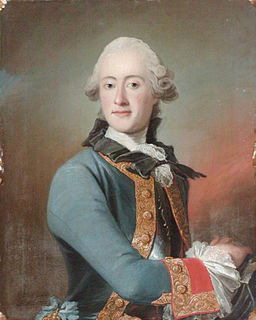
Frederik Christian Kaas was a Danish naval officer and landowner.
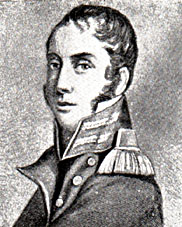
Hans Peter Holm was a Danish naval officer who commanded vessels of the Dano-Norwegian Navy in several actions. He commanded several naval vessels during the Gunboat War. His most important action occurred in 1812 at the Battle of Lyngør when a British squadron, led by the British ship-of-the-line HMS Dictator, destroyed his vessel, HDMS Najaden. Holm sustained wounds in the battle but survived, only to drown in an accident shortly afterwards.
The name of Steen Andersen Bille is closely associated with one extended family of Danish naval officers over several generations.
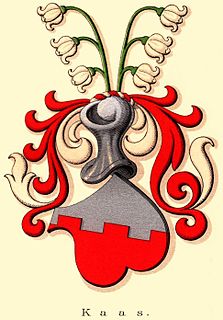
Jørgen Kaas was a Danish colonel, lord of the fiefdom Lister in Norway, and owner of the Hastrup and Østergaard estates in Denmark. A member of the younger Kaas family, one of Denmark's preeminent families of ancient high nobility, he is notable as a war hero during the March across the Belts when he led the defense of Fyn against the Swedes and fell in battle. King Charles X Gustav of Sweden accompanied his body on foot in honour of his bravery. He was given the fief of Lister by King Christian IV on 30 December 1648, after he had sold his estate Østergaard to the King's son Ulrik Christian Gyldenløve. He never resided in Norway, and the fief was administered by the fiefholder of Nedenes.

Kaas is the name of two related Danish noble families from Jutland, which were and are, respectively, two of the preeminent families of the Danish Uradel or ancient high nobility, which were represented in the Council of the Realm. They are known as the elder Kaas family and the younger Kaas family or named for their respective coats of arms. Both families appeared in the middle ages, and they have been noble since time immemorial. Like all old noble families in Scandinavia, the families are untitled, although individual members in the past held the rank of knight, traditionally the highest rank of Scandinavian nobility and reserved for important statesmen, but always of a non-hereditary nature.
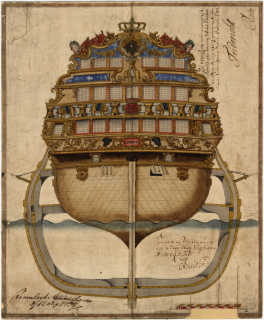
HDMS Elephanten was a ship of the line of the Royal Dano-Norwegian Navy that served from 1703 to 1728. There were three other Danish ships-of-the line of the same name, dating from 1684, 1741 and 1773. The ship was sometimes referred to as Nye Elefant to differentiate from others of similar name. For much of her service career, which coincided with the Great Northern War, Elephanten was the flagship of the Danish fleet active in the Baltic Sea.

Christian Wulff was a Danish naval officer. He commanded HDMS Bellona on her expedition to South America in 1840–41.
Andreas Lous was a Danish naval officer responsible for early navigational charts of Danish Waters and the dredging of harbours, in addition to sea-time on various Danish warships. He was captain of the ship-of-the-line HDMS Printz Friderich when she ran aground in 1780 near Læsø and was a total loss.

HDMS Printz Friderich was a ship-of-the-line launched in 1764, to a design by Frederik Michael Krabbe, a naval officer and leading ship designer of that period. Two other ships — Norske Løve and Øresund — were constructed to the same design. Little is known of her service history beyond that she received a new keel in 1775. She was lost in 1780. Her wreck was rediscovered in 2018.
The family name Stibolt was closely associated with the Danish-Norwegian navy of the 18th century and with the island of Christiansø from the time that Hans Anderson Stibolt was appointed commandant of those most easterly islands of Denmark. His three sons all held naval officer rank, as did many of the subsequent generations, serving with a varied amount of success. Three generations held the post of Commandant on Christiansø.
HDMS Hvide Ørn , was a light frigate designed by Frantz Hohlenberg and built in Copenhagen. She capsized and was lost with all hands off Corsica at the end of 1799. There were three previous ships bearing this name in the Danish navy.
Frederik Michael Krabbe (1725–1796) was a Danish naval officer and master shipbuilder (fabrikmester)
Rasmus Krag (1680–1755) was a Danish naval officer who first became a junior lieutenant in 1700 and vice-admiral in 1736. He aspired to be a naval architect but his efforts proved unsatisfactory.

Frederik Christian Kaas (1725–1803) was a naval officer and admiral in the service of the Danish Crown.
HDMS Nidelven was a brig launched at Copenhagen on 1 December 1792. She was present at both British attacks on Copenhagen, and the British Royal Navy seized her at Copenhagen on 7 September 1807 at the surrender of Copenhagen. The British took her into service as HMS Nid Elven. She served between 1808 and 1809, during which time she captured a small French privateer. She was laid up in 1809. The Navy sold her in 1814.

Frederik Kaas was a Danish naval officer who also saw service with other navies. He died in the Battle of Pondicherry in a French warship.
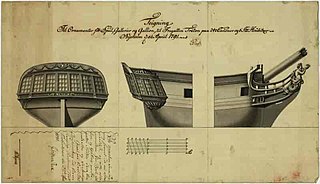
HDMS Triton (1790)

Ulrich Jørgensen Kaas, a member of the old noble family of Mur Kaas, was an officer in the Dano-Norwegian navy who rose to the rank of Rear Admiral in the Great Northern War and later to full Admiral in 1732. Following a power struggle within the Danish admiralty, he left the naval service for a senior post in Bergen.

Ulrik Christian Kaas, a member of the old noble family of Mur Kaas, was a Danish naval officer who rose to the rank of admiral.
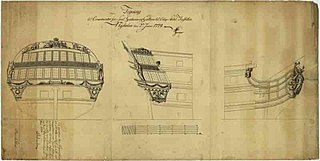
HDMS Justitia was a Royal Dano-Norwegian Navy ship-of-the-line, built to a design by Henrik Gerner. Although launched in 1777, she was not fully commissioned until 1780. The British Royal Navy seized her in 1807, together with the rest of the Danish fleet after the second battle of Copenhagen. The British never commissioned Justitia. A renaming to Orford in 1809 was cancelled. She was broken up in 1817.
References
- ↑ Topsøe-Jensen Vol 1 p 699
- ↑ Topsøe-Jensen Vol 1 p 700
- ↑ Topsøe-Jensen Vol 1 p 700
- ↑ Topsøe-Jensen Vol 1 p 701
- ↑ Topsøe-Jensen Vol 1 p 702
- ↑ Topsøe-Jensen Vol 1 p 703
- ↑ Topsøe-Jensen Vol 1 p 705
- ↑ Topsøe-Jensen Vol 1 p 708
- ↑ Topsøe-Jensen Vol 1 p 709
- ↑ Topsøe-Jensen Vol 1 p 710
- ↑ Topsøe-Jensen Vol 1 p 712
- ↑ Topsøe-Jensen Vol 1 p 712
- ↑ Topsøe-Jensen Vol 1 p 713
- ↑ Projekt Runeberg DBL Vol IX p 71
- ↑ Salmonsen
- ↑ Gravsted
- ↑ Topsøe-Jensen Vol 1 p 715
- ↑ Topsøe-Jensen Vol 1 p 717
- ↑ Topsøe-Jensen Vol 1 p 717
- ↑ Topsøe-Jensen Vol 1 p 718